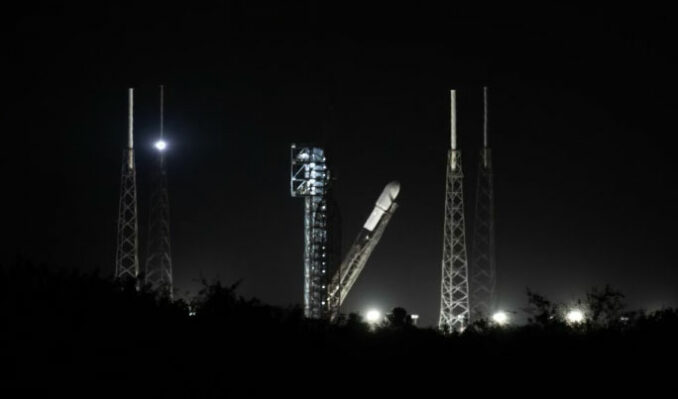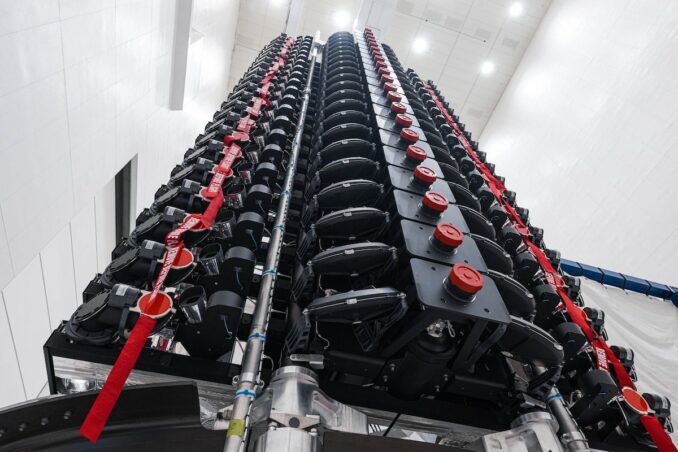SpaceX was racing to get a Falcon 9 rocket ready to fly from Cape Canaveral Tuesday evening as launch preparations fell behind schedule. Currently liftoff with a batch of 23 Starlink satellites is planned for 2:27 a.m. EST (0727 UTC) Wednesday morning.
由於發射準備工作落後於計劃,SpaceX 正在加緊準備週二晚上從卡納維爾角發射的獵鷹 9 號火箭。目前,一批 23 顆星鏈衛星計畫於美國東部時間週三凌晨 2:27(0727 UTC)升空。
The Starlink 6-29 mission was originally targeted for 11:01 p.m. EST (0401 UTC) on Tuesday night but SpaceX pushed back the launch to 1:47 a.m. EST (0647 UTC) and then 2:27 a.m. EST (0727 UTC). There are two more launch opportunities Wednesday morning, the last one coming at 2:59 a.m. EST (0759 UTC).
Starlink 6-29 任務原定於晚上 11:01 進行。美國東部標準時間 (0401 UTC) 週二晚上發射,但 SpaceX 將發射推遲到東部標準時間凌晨 1:47 (0647 UTC),然後推遲到東部標準時間凌晨 2:27 (0727 UTC)。週三上午還有兩次發布機會,最後一次發佈時間為美國東部時間凌晨 2:59(世界標準時間 0759)。
The Falcon 9 rocket was lifted upright at Space Launch Complex 40 shortly before 10 p.m. EST (0300 UTC), much later than would have been expected. The previous mission from pad 40 lifted off just four days earlier so if the current launch time sticks this would be the seventh fastest turnaround attempt for the launch facility.
晚上 10 點前不久,獵鷹 9 號火箭在 40 號航太發射場被直立昇空。美國東部時間(0300 UTC),比預期晚得多。上一次從 40 號發射台發射的任務僅在四天前發射,因此如果當前的發射時間不變,這將是該發射設施第七次最快的周轉嘗試。

The Falcon 9 rocket is lifted upright at Space Launch Complex 40 as SpaceX presses ahead with plans for a Starlink delivery mission. Image: Adam Bernstein/Spaceflight Now.
隨著 SpaceX 繼續推進星鏈發射任務計劃,獵鷹 9 號火箭在 40 號航太發射場被直立昇空。圖:亞當伯恩斯坦/Spaceflight Now。
U.S. Space Force meteorologists at the 45th Weather squadron said Monday weather conditions would be 90-percent favorable at the time of the first opportunity with chances dropping slightly to 75-percent at the end of the launch window.
美國太空軍第 45 氣像中隊的氣象學家週一表示,第一次機會時,天氣條件有利的機率為 90%,而在發射窗口結束時,機率略有下降至 75%。
After lifting off from Cape Canaveral, the Falcon 9 will set off on a south-easterly trajectory targeting an orbit inclined 43 degrees to the Equator. After burning its nine Merlin 1D engines for nearly two and a half minutes, the first stage will separate from the second stage and continue downrange to land on the drone ship ‘A Shortfall of Gravitas’ in the Atlantic Ocean, about 424 miles (682 km) from the launch site.
從卡納維爾角升空後,獵鷹 9 號將沿著東南軌道起飛,目標軌道與赤道傾斜 43 度。在燃燒其九個Merlin 1D 發動機近兩分半鐘後,第一級將與第二級分離,並繼續下降降落在大西洋上的無人機船“A Shortfall of Gravitas”上,距離約424 英里( 682 公里) )從發射場。

File photo of SpaceX’s Starlink V2 Mini satellites inside a payload processing facility at Cape Canaveral earlier this year. Credit: SpaceX
今年早些時候,SpaceX 的 Starlink V2 Mini 衛星在卡納維爾角有效載荷處理設施內的檔案照片。圖片來源:SpaceX
Meanwhile, high above, the single vacuum Merlin engine of the second stage will fire for about six-minutes to reach a parking orbit. After coasting for about 45 minutes, the second-stage engine will re-ignite for a two-second burn to refine the orbit. Deployment of the 23 V2 Mini Starlink satellites will follow at about one hour and five minutes after launch.
同時,在高空,第二級的單真空 Merlin 引擎將點火約六分鐘,以到達停車軌道。滑行約 45 分鐘後,第二級引擎將重新點火,燃燒兩秒以完善軌道。 23 顆 V2 迷你星鏈衛星將在發射後約 1 小時 5 分鐘內部署。
It will be SpaceX’s 87th orbital launch of the year and the 276th flight of a Falcon 9 rocket to date.
這將是 SpaceX 今年的第 87 次軌道發射,也是迄今為止獵鷹 9 號火箭的第 276 次飛行。
Spaceflight Now’s live coverage of the launch will get underway about an hour before liftoff. You can also watch 24-7 views of launch pads at the Cape in our Launch Pad Live stream.
Spaceflight Now 對此發射的現場報道將在發射前約一個小時進行。您也可以在我們的發射台直播中觀看海角發射台的 24-7 視圖。


 Optimisus
Optimisus DogeHome
DogeHome Crypto News Land
Crypto News Land Optimisus
Optimisus Crypto News Land
Crypto News Land Crypto News Land
Crypto News Land Optimisus
Optimisus Cryptopolitan_News
Cryptopolitan_News






















